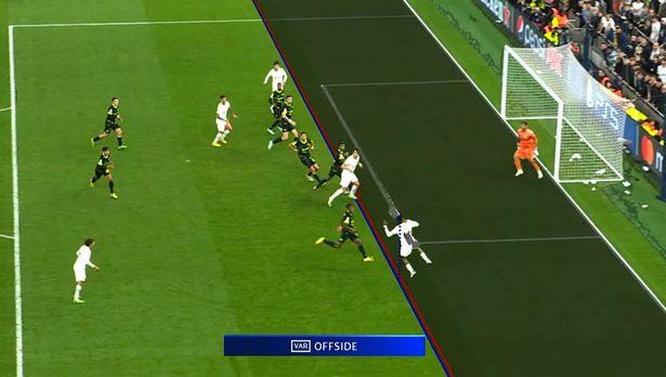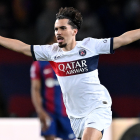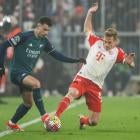
The final minutes of Champions League Matchday 5 will be remembered for the game-changing decisions made by the referee teams, who had the assistance of VAR to help them ultimately make the correct decisions. But if you are left stunned and not fully sure why the decisions were correct, you're not alone, so let's get you up to speed.
Let's start with Tottenham's Harry Kane's shattered heroic goal being disqualified in the final 15 seconds of the 1-1 draw between Tottenham and Sporting Lisbon. In principle, this decision is rather straightforward. The central question is, "whether Kane was in an offside position when Emerson played it."
DRAMA IN NORTH LONDON! 🍿
— CBS Sports Golazo ⚽️ (@CBSSportsGolazo) October 26, 2022
Harry Kane thought he'd sent Spurs into the #UCL knockout phase, but VAR disallows the goal and Antonio Conte is shown red. 😮 pic.twitter.com/MZWHcKjneP
The laws state that a player is in an offside position if any part of the head, body, or feet is in the opponent's half (excluding the halfway line) AND any part of the head, body, or feet is nearer to the opponent's goal line then both the ball and the second-last opponent.
Why people are confused is because of two red herrings:
- The ball was played backward by Emerson AND
- Then it was redirected forwarded because it hit off Flavio Nazinho
Let's break both those parts of the play down.
1. Does it matter that the ball was played backwards?
The backward argument is based on other plays people are familiar with, where they see an attacker beat all the defenders and then play the ball laterally or slightly backward to an onrushing teammate who has already passed the second-to-last defender. In those instances, there is no offside because the oncoming attacker is not closer to the goal line than BOTH the ball and the second-to-last defender. The ball is closer to the goal line than the receiving player, so they are not in an offside position.
But with Kane, when the ball is first played by Emerson (even though it's played backward), Kane is in an offside position because he is nearer to the goal line than BOTH the ball and the second-to-last defender.

This image is the first part of the semi-automated offside technology (SAOT). Instantly, when Kane receives the ball from Emerson, this 2D graphic is automatically created, selecting the kick point and automatically applying the offside line on the second to last defender.
However, this play is different than most because the offside line must be set on the part of the ball closest to the goal as opposed to the defender. And in the Champions League, the ball does not have a sensor. This part of the technology is changing though, and in the FIFA World Cup, it will. UEFA Champions League chose not to include the sensor in the ball, but in the FIFA World Cup, they will have it.
These two items explain why it took the referee team almost four minutes to confirm this decision. While in most cases the SAOT will generate the offside line automatically because it is based purely on player positioning at the time the ball is played, in this case it only gave the VAR Kane's position and, since the relevant question is whether Kane was behind the ball when the pass was played, the VAR had to manually review all the camera angles and confirm the exact frame from when the ball was played by Emerson to lock in not just the kick point but also to determine the offside line. The decision is tight but pretty clear once you confirm all the angles and set the final image.
Spurs were so close to the #UCL knockout stage!@ChristinaUnkel explains why Harry Kane had his winner disallowed to @Carra23, @micahrichards, @Pschmeichel1 and Thierry Henry.
— CBS Sports Golazo ⚽️ (@CBSSportsGolazo) October 26, 2022
Good luck 😅 pic.twitter.com/6eXQWoLw1Z
For those asking about the 3D graphic, it's important to know that the 3D graphic that comes with SAOT is only created after the reference points are confirmed and are not immediately available to show in real time. This is why you typically see the 3D graphic a couple of minutes after the incident because it requires more time to be created, but when it is done, then they must wait for an appropriate or relevant stoppage in the game to show the 3D graphic to the viewers at home and the fansUEFA Champions League chose not to include the sensor in the ball, but in the FIFA World Cup, they will have it in the stadium. Basically, the image is a useful way to explain the decision, but it's an after-the-fact tool.
This is why the only replays the viewers received of Kane in an offside position were the 2D model with the blue and red lines because the game was essentially over, and there was no time or opportunity to create the 3D graphic and show the viewers.
This is an opportunity where semi-automated offside technology can improve in the Champions League by adding both the sensor to the ball and obtaining or developing technology that can create 3D graphics almost instantaneously. The ball sensor is typically used only to know when it was kicked as it tracks velocity, but in the Kane offside it demonstrates that it can speed up the time it takes to determine the offside position when the ball sets the offside line. And the 3D graphic reinforces the critical decision to everyone as the 2D graphic isn't as convincing.
2. Does it matter that the ball deflects off of a defender?
Let's look at the next red herring, the argument that since the ball deflected off of a Sporting defender, Nazhino, the play can't be offside. That's an incorrect understanding of the exception known as deliberate play vs. deflection in the offside analysis.
The offside law states that a player in an offside position who receives the ball from the defender who deliberately plays the ball is not considered to gain an advantage. In July of this year, IFAB clarified and provided further guidelines to distinguish between "deliberate play" and "deflection":
It is considered deliberate play when:
- The ball traveled from a distance, and the player had a clear view of it
- The ball was not moving quickly
- The direction of the ball was not unexpected
- The player had time to coordinate their body movements, so not instinctive stretching or jumping
- The ball is easy to play (one of the considerations being that a ball moving on the ground is easier to play than one in the air)
The contact on Nazhino is a clear deflection and not deliberate because the distance from when Emerson played the ball to when it hit Nazhino was close; the ball did move quickly; the ball's direction was unexpected as it went backward instead of laterally or forward; Nazhino had no time to react; and, the ball was in the air when it hit him.
Final Decision: Offside disqualifying the goal
Atletico vs. Bayer Leverkusen penalty chaos
The next major heartbreak also occurred in the final seconds in additional time in the Atletico vs. Bayer Leverkusen match. Only seconds remained when the ball went out for a corner kick level at 1-1.
It is important to note that the recommended practice for referees is to permit a corner kick to be taken if the ball crosses the line before time has ended. However, if time had concluded before the ball goes out for a corner kick or another set piece to restart play, the referee should conclude the game and not allow the corner kick or set piece to take place. This is important because everyone is under the impression that referees are required to allow a corner kick to take place even if time has run out, and that is not true, only if time was still available before the ball crossed a touchline or was out of play for another reason.
So this play was what I like to call a unicorn - why? Because it highlighted an area in the law that is either incomplete or needs to be clarified as to what would have happened if Atletico scored on the rebound. Or it should be deleted completely to avoid confusion. This play runs deeper than just the VAR recommendation for a penalty; it could have gotten even wilder.
In breaking down this complex play, it is critical to know the sequence and timing of events:
- 90:00: Referee has indicated a minimum of 5' minutes of additional time.
- 94:46: The ball goes out for a corner with only 14 seconds left in additional time.
- 95:01: Before the ball can be put into play from the corner kick, referee has to delay the game to issue Atletico coach a yellow card for significantly leaving his technical area.
- 95:19: Referee blows the whistle to indicate corner kick can resume.
- 95:20: Corner kick is taken.
- 95:21: Two potential handling offense occurs that the referee does not call either as a penalty.
- 95:23: Referee blows the whistle to indicate the end of the game once the cross comes in and the attacking play has ended. Immediately you can see the VAR has informed the referee that he is checking a possible penalty and to keep the players on the field until he can complete his review.
What just happened there?!@ChristinaUnkel tries to make sense of the closing stages of Atletico v Leverkusen. pic.twitter.com/O1woPYOhJC
— CBS Sports Golazo ⚽️ (@CBSSportsGolazo) October 26, 2022
Ultimately the VAR does recommend an on-field review for handling by Leverkusen's Piero Hincapie, which the referee accepts and indicates a penalty kick will be taken. Handling offense does occur: (i) the hand/arm is beyond the silhouette, and (ii) it creates a barrier. There's no controversy about the decision. It's a good VAR recommendation and acceptance of the recommendation by the referee.
For many, this is where it ends. A penalty kick is taken and blocked, a follow-up shot hits the crossbar, and another follow-up shot goes wide. And everyone's heart is in their throats, and they move on - unless you know the laws.
If you know the laws, here is where it gets even wilder and highlights a conflict or incomplete area of the law that could result in an absurd outcome that's never been seen before (or at least that I can recount and what I've researched).
If the opposite had been true in what played out during the penalty, if Atletico had scored on one of the rebounds in that penalty, there's an area in the law that would have required Referee Clement Turpin to disallow the goal.
Under Law 14, The Penalty Kick, it states:
Additional time is allowed for a penalty kick to be taken and completed at the end of … the match or extra time. When additional time is allowed, the penalty kick is completed when, after the kick has been taken, the ball stops moving, goes out of play, is played by any player (including the kicker) other than the defending goalkeeper, or the referee stops play for an offense by the kicker or the kicker's team. If a defending team player (including the goalkeeper) commits an offense and the penalty is missed/saved, the penalty is retaken.
So, in theory, what this means is if the referee determines the game is done and there was no additional time, the referee can add more time for taking the penalty kick, but it would look more like a kick from the penalty mark - just the kicker and the goalkeeper as no one else can touch the ball when the kick concludes as stated under Law 14, The Penalty Kick.
No one has seen this occur before, especially at the highest level of football. And here is where we have a conflict in law from what referees do in practice vs. theoretical and why Law 14 must be either rewritten to clarify it or deleted entirely.
In practice, practical referees do what Turpin did and what the entire football world expects, let the penalty kick take place and the immediate aftermath and to conclude once that last phase of play occurs. But that's technically not what the law calls for.
In order for the laws to allow for the play after the penalty kick to continue, we would need to determine that we still had time within the original 5 minutes minimum time indicated and are not adding time only for the taking of the kick. The distinction between whether time ran out and adding time just for the kick or there is still time in the additional five for the penalty to be taken is the difference between letting a rebound goal count or not.
That's why the rule should be amended. We should treat it just as we would the corner kick play. If the ball had left the field before time ran out, let the play run its course, and then call the game.
Final Decision: VAR recommendation and acceptance for penalty kick. Treat the penalty kick as part of the already determined additional time, and let the play conclude naturally.
For those who would like to argue that they would have treated the Atletico penalty under Law 14 and would have negated any goal not directly scored by Yannick Carrasco in the first kick, I'll leave you with these words of my wise mentor Herb Silva: "Call me, I want to come watch you try it."





















